Safety Harbor Waterfront Park Phase II could be phased, too
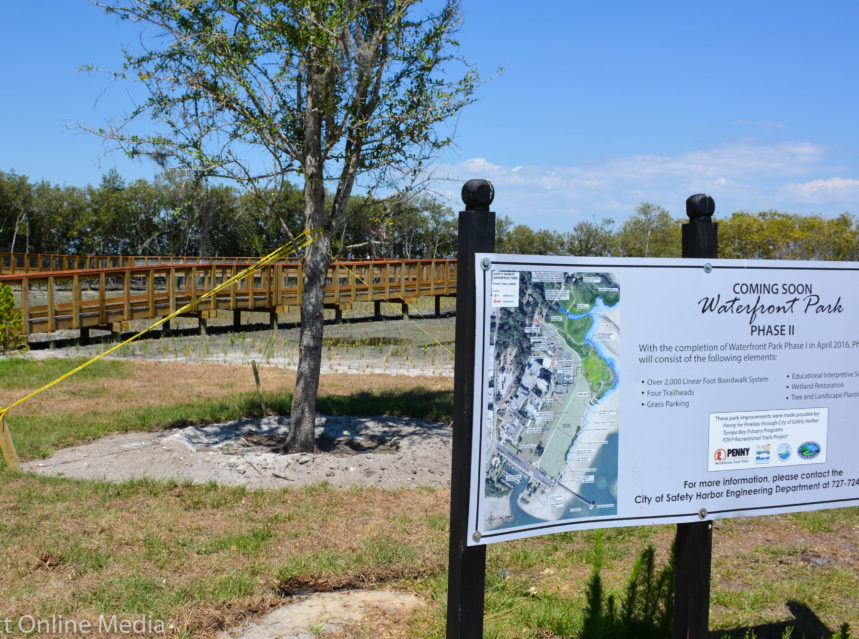
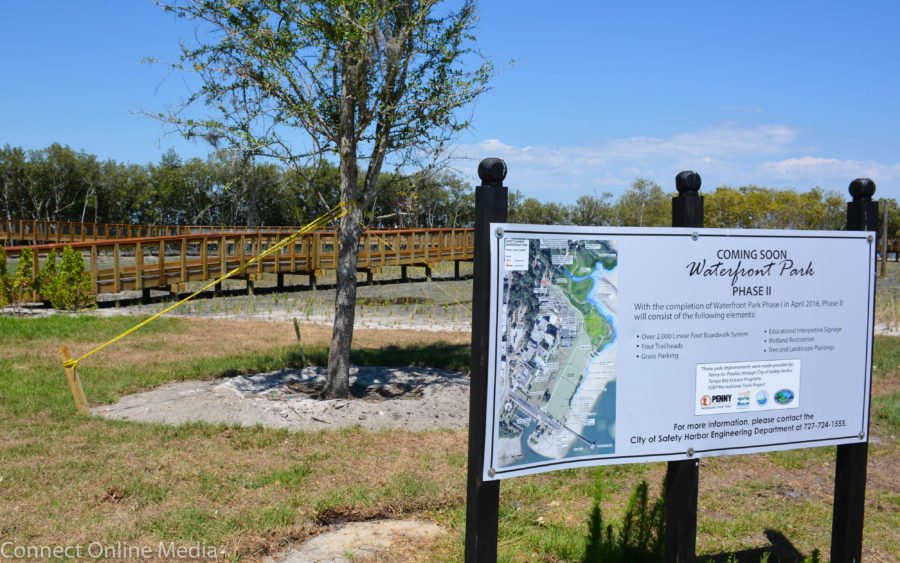
It’s been nearly five months since work was completed on the second stage of Phase 1 of Safety Harbor’s Waterfront Park, a $1.8 million project that added a scenic 2,500-linear-foot trail along the park’s shoreline.
In the spring, officials began discussing Phase II of the development of the 13-acre parcel located behind the Safety Harbor Spa that the City purchased from the resort for $2.75 million in 2015.

During a City Commission meeting on April 17, the five city commissioners agreed to combine elements from the initial conceptual plans for the park and recommendations made by a steering committee, creating a concept that would feature additional parking and sidewalks, restroom improvements, a kayak launch and temporary boat slips as well as new seating and shaded areas plus upgrades to the electrical and irrigation systems.
Last week, City Manager Matt Spoor presented the commission with the budget for ‘Concept B,’ a nearly $2 million proposal that did not include all the requested elements.
“The budgeted cost for this Concept B is just under two million dollars, around $1.9 million, (and) it does not include the cost of the transient boat slips, the kayak launch or the northern shelter,” he said.
Spoor said that $400,000 in parkland funds have been earmarked in the FY 2018 budget for the park work, plus $75,000 that was left over from the Phase I work.
“So you would have a Fiscal Year ’18 projected budget of $475,000, right now, for any additional work out at the Waterfront Park,” he said.
With such a disparity between the available funds and the projected cost of the requested work, the commissioners were forced to make some decisions before directing Spoor as to how to move forward.
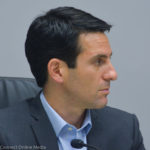
“I think the Waterfront Park is crucial to our city and our downtown, I think it’s gonna be almost like the crown jewel of the city moving forward,” Mayor Joe Ayoub said on Nov. 21. “I think it’s gonna attract a lot of people, I think it’s gonna attract a lot of events. I think it’s worth the investment.”
Ayoub noted that he felt the cost of the restroom upgrades—just over $650,000—was “rather high” and he suggested using money from the city’s reserves to complete the next phase.
“Ideally, I’d like to see everything that we agreed to on this Concept B, if we could try to find a way to make the numbers work,” he said.
“I know we have extra money in reserves that we’re not using…and if there’s any time and any place to spend it, I think this would be a great return on investment.”
The suggestion led to a lengthy discussion centered on the park’s restrooms.
Initially, the concept called for the demolition of the existing building and the construction of an elevated, two-story bathroom and storage facility with a ramp, stairs and a deck, just east of the current location closer to the pier.
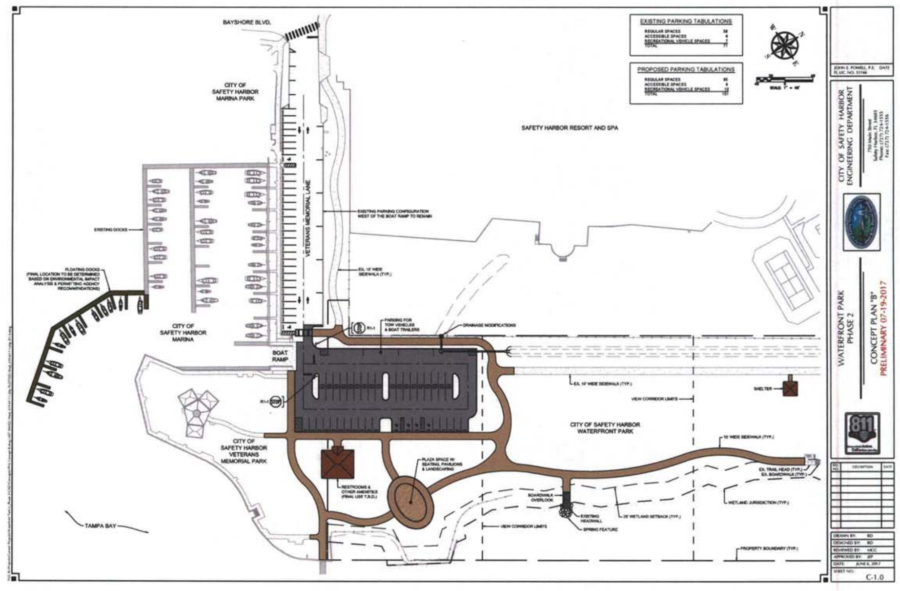
The area where the building now sits would become part of a new parking lot, complete with boat trailer spots as well roughly 60 additional parking spaces.
While everyone agreed the current building—an aging facility that floods during heavy rains that’s inadequate for the number of visitors coming to the waterfront—is untenable in the long term, the high price tag for the proposed upgrade was impossible to get around for some.
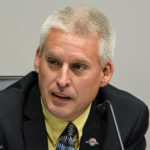
“It is a really high cost,” Commissioner Scott Long said.
“I’m not saying it’s wrong, but it is hard to swallow.”
Long said if they delayed the restroom portion of the project, that would drop almost $700,000 off the proposed budget and then “we can do most of the other stuff around it.”
The commissioners ultimately instructed Spoor to move forward with coming up with a proposal that includes all the elements of Concept B, including the northern shelter, a natural “living” shoreline and a plaza space, minus the new restrooms and the kayak launch, with Ayoub stating he hoped they could be included in a second part of Phase II.
After the meeting, Spoor outlined the next steps regarding the proposed Waterfront Park work.
“I’m meeting with staff this week to go over everything that was discussed at the meeting, and we’ll be back before the commission after the New Year with a new budget, an estimated schedule and funding options for the work they want done,” Spoor told Safety Harbor Connect this week.
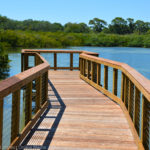
He estimated the revised budget could be around $1.5 million and cautioned that even if the project proceeds without the restroom upgrades, the work might not begin until late next year.
“Grant and permit applications take time to apply for and process,” Spoor said, noting the lengthy delay securing a key permit for the boardwalk. “So I’d conservatively say sometime in 2018, by the end of 2018.”
“We’re going to give them options, timeframe and budget wise, but the budget is clearly over what we have budgeted for the park for Fiscal Year 18, so they’re going to have to make decisions about funds and what they want to happen and when.”
According to Ayoub, the sooner they can start the work, the better.
“Adding additional amenities like a shade pavilion and additional landscaping to our Waterfront Park has been a huge priority of mine and I’m excited that the commission is interested in moving this forward,” he said via email.
“It was great that the commission agreed on the plans to move forward with a couple months ago and now we just need to work within our budget to get our goals accomplished. As I’ve always said I’m fine using the excess reserves that we have to invest in our beautiful waterfront, which will be a focal point for our city for decades to come!”
Related content:
- With boardwalk complete, Safety Harbor officials discuss Waterfront Park Phase II
- Safety Harbor Waterfront Park boardwalk offers serenity amid stunning natural beauty
- Hundreds turn out to install thousands of plants at Safety Harbor Waterfront Park


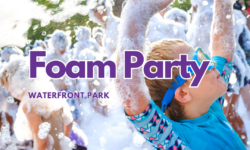


That’s frustratingly lame that they will have to carry out such a small project in phases, but then the city has a pitiful amount of money to spend, so I guess it’s not too surprising. I would’ve hoped that a parking lot expansion would go elsewhere, since there’s no way anyone will be allowed to park there during events downtown and it’ll create a visual barrier between the water and the park– it’s exactly what they’re trying to eliminate with Coachman Park in Clearwater. I suppose if the city were to start holding events at the park itself it could still get some use, especially if the bandshell idea ever comes to fruition. Still, why not move the parking lot to the other end of the park, next to the tennis courts and along North Bayshore next to the boardwalk? You’d probably end up with fewer parking spots, but at least they’d actually be available when they’re needed.
All for phasing out the parking on Waterfront Park property and adding shade trees instead of palm trees outside the view corridor which is more affordable and aesthetically pleasing than asphalt. Again, the city would be better off with an interactive water element at the end of Veterans Parkway which would be the crossing area for pedestrians and cyclists from Veterans Memorial area to the Waterfront Park. Although we would loose some parking, we would gain more usage of the park. We need to create an attraction and shade for residents to utilize in addition to the board walk at the north end. Leave the bathrooms alone for now, since we are not trying to highlight our city restrooms, but rather the park. We should probably create some beach/sand volleyball areas along the shoreline like St. Petersburg did with their waterfront park area by North Shore Pool. Oh, and an in ground small natural amphitheater (grass seating and small concrete stage) in the northeast corner of the park would be a huge draw for Third Friday, music events, weddings, etc.
I have to agree with Tammy. Way too much parking on prime waterfront park. We need to figure out a better option. I would give up the connection to veterans park before adding all this new parking. That size lot and its location create too much visual and physical barrier.
How about reduce the parking? That is an obscene parking lot and for what exactly? Go drive your car, park, and then walk at the park?
Agree. Excessive parking on valuable waterfront land is a waste of a scarce resource and would detract from the natural beauty and overall attractiveness of the park. Nearby cities are removing parking from their waterfronts to make them more people oriented and vibrant (and to the reduce the heat island effect). Add some handicapped spaces and a drop off area. Create better walking and biking connections to neighborhoods beyond. Establish a park and ride shuttle to operate during large events. Preserve and enhance this unique and special place. Pave over it as sparingly as possible. Mullet Creek Park is a perfect example of going overboard with parking. Rarely more than one car in that sizable parking lot.